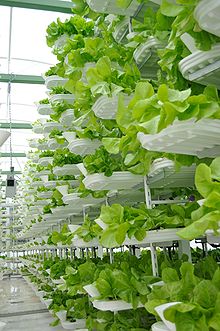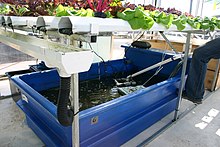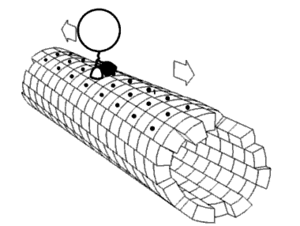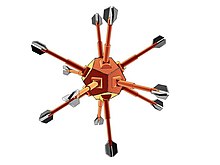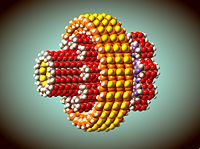Nanochemistry is the combination of chemistry and nano science. Nanochemistry is associated with synthesis of building blocks which are dependent on size, surface, shape and defect properties. Nanochemistry is being used in chemical, materials and physical, science as well as engineering, biological and medical applications. Nanochemistry and other nanoscience fields have the same core concepts but the usages of those concepts are different.
The nano prefix was given to nanochemistry when scientists observed the odd changes on materials when they were in nanometer-scale size. Several chemical modification on nanometer scaled structures, approves effects of being size dependent.
Nanochemistry can be characterized by concepts of size, shape, self-assembly, defects and bio-nano; So the synthesis of any new nano-construct is associated with all these concepts. Nano-construct synthesis is dependent on how the surface, size and shape will lead to self-assembly of the building blocks into the functional structures; they probably have functional defects and might be useful for electronic, photonic, medical or bioanalytical problems.
Silica, gold, polydimethylsiloxane, cadmium selenide, iron oxide and carbon are materials that show the transformative power of nanochemistry. Nanochemistry can make the most effective contrast agent of MRI out of iron oxide (rust) which has the ability of detecting cancers and even killing them at their initial stages. Silica (glass) can be used to bend or stop light in its tracks. Developing countries also use silicone to make the circuits for the fluids to attain developed world's pathogen detection abilities. Carbon has been used in different shapes and forms and it will become a better choice for electronic materials.
Overall, nanochemistry is not related to the atomic structure of compounds. Rather, it is about different ways to transform materials into solutions to solve problems. Chemistry mainly deals with degrees of freedom of atoms in the periodic table however nanochemistry brought other degrees of freedom that controls material's behaviors.
Nanochemical methods can be used to create carbon nanomaterials such as carbon nanotubes (CNT), graphene and fullerenes which have gained attention in recent years due to their remarkable mechanical and electrical properties.
Nanotopography
Nanotopography refers to the specific surface features which appear on the nanoscale. In industry, applications of nanotopography typically encompass electrics and artificially produced surface features. However, natural surface features are also included in this definition, such as molecular-level cell interactions and the textured organs of animals and plants. These nanotopographical features in nature serve distinctive purposes that aid in regulation and function of the biotic organism, as nanotopographical features are extremely sensitive in cells.
Nanolithography
Nanolithography is the process by which nanotopographical etchings are artificially produced on a surface. Many practical applications make use of nanolithography, including semiconductor chips in computers. There are many types of nanolithography, which include:
- Photolithography
- Electron beam lithography (EBL)
- X-ray lithography
- Extreme ultraviolet lithography (EUVL)
- Light coupling nanolithography (LCM)
- Scanning probe microscope lithography (SPM)
- Nanoimprint lithographyh
- Dip-Pen nanolithography
- Soft lithography
Each nanolithography technique has varying factors of resolution, time consumption, and cost. There are three basic methods used by nanolithography. One involves using a resist material which acts as a "mask" to cover and protect the areas of the surface that are intended to be smooth. The uncovered portions can now be etched away, with the protective material acting as a stencil. The second method involves directly carving the desired pattern. Etching may involve using a beam of quantum particles, such as electrons or light, or chemical methods such as oxidation or SAM's (self-assembled monolayers). The third method places the desired pattern directly on the surface, producing a final product that is ultimately a few nanometers thicker than the original surface. In order to visualize the surface to be fabricated, the surface must be visualized by a nano-resolution microscope, which include the scanning probe microscope (SPM) and the atomic force microscope (AFM). Both microscopes can also be engaged in processing the final product.
SAM's
One of the methods of nanolithography is use of self-assembled monolayers (SAM) which develops soft methodology. SAMs are long chain alkanethiolates that are self-assembled on gold surfaces making a well-ordered monolayer films. The advantage of this method is to create a high quality structure with lateral dimensions of 5 nm to 500 nm. In this methodology a patterned elastomer made of polydimethylsiloxane (PDMS) as a mask is usually used. In order to make a PDMS stamp, the first step is to coat a thin layer of photoresist onto a silicon wafer. The next step is to expose the layer with UV light, and the exposed photoresist is washed away with developer. In order to reduce the thickness of the prepolymer, the patterned master is treated with perfluoroalkyltrichlorosilane. These PDMS elastomers are used to print micron and submicron design chemical inks on both planar and curved surfaces for different purposes.
Applications
Medicine
One highly researched application of nanochemistry is medicine. A simple skin-care product using the technology of nanochemistry is sunscreen. Sunscreen contains nanoparticles of zinc oxide and titanium dioxide. These nanochemicals protect the skin against harmful UV light by absorbing or reflecting the light and prevent the skin from retaining full damage by photoexcitation of electrons in the nanoparticle. Effectively, the excitation of the particle blocks skin cells from DNA damage.
Drug delivery
Emerging methods of drug delivery involving nanotechnological methods can be advantageous by improving increased bodily response, specific targeting, and efficient, non-toxic metabolism. Many nanotechnological methods and materials can be functionalized for drug delivery. Ideal materials employ a controlled-activation nanomaterial to carry a drug cargo into the body. Mesoporous silica nanoparticles (MSN) have been increasing in research popularity due to its large surface area and flexibility for various individual modifications while demonstrating high resolution performance under imaging techniques. Activation methods greatly vary across nanoscale drug delivery molecules, but the most commonly used activation method uses specific wavelengths of light to release the cargo. Nanovalve-controlled cargo release uses low intensity light and plasmonic heating to release the cargo in a variation of MSN containing gold molecules. The two-photon activated photo-transducer (2-NPT) uses near IR wavelengths of light to induce breaking of a disulfide bond to release the cargo. Recently, nanodiamonds have demonstrated potential in drug delivery due to non-toxicity, spontaneous absorption through the skin, and ability to enter the blood-brain barrier.
Tissue engineering
Because cells are very sensitive to nanotopographical features, optimization of surfaces in tissue engineering has pushed the frontiers towards implantation. Under the appropriate conditions, a carefully crafted 3-dimensional scaffold is used to direct cell seeds towards artificial organ growth. The 3-D scaffold incorporates various nanoscale factors that control the environment for optimal and appropriate functionality. The scaffold is an analog of the in vivo extracellular matrix in vitro, allowing for successful artificial organ growth by providing the necessary, complex biological factors in vitro. Additional advantages include the possibility of cell expression manipulation, adhesion, and drug delivery.
Wounds
For abrasions and wounds, nanochemistry has demonstrated applications in improving the healing process. Electrospinning is a polymerization method used biologically in tissue engineering, but can be functionalized for wound dressing as well as drug delivery. This produces nanofibers which encourage cell proliferation, antibacterial properties, and controlled environment. These properties have been created in macroscale; however, nanoscale versions may show improved efficiency due to nanotopographical features. Targeted interfaces between nanofibers and wounds have higher surface area interactions and are advantageously in vivo.
There is evidence certain nanoparticles of silver are useful to inhibit some viruses and bacteria.
New developments in nanochemistry provide a variety of nanostructure materials with significant properties that are highly controllable. Some of the application of these nanostructure materials include SAMs and lithography, use of nanowires in sensors, and nanoenzymes.
Electrics
Nanowire compositions
Scientists have also devised a large number of nanowire compositions with controlled length, diameter, doping, and surface structure by using vapor and solution phase strategies. These oriented single crystals are being used in semiconductor nanowire devices such as diodes, transistors, logic circuits, lasers and sensors. Since nanowires have one dimensional structure meaning large surface to volume ratio, the diffusion resistance decreases. In addition, their efficiency in electron transport which is due to the quantum confinement effect, make their electrical properties be influenced by minor perturbation. Therefore, use of these nanowires in nanosensor elements increases the sensitivity in electrode response. As mentioned above, one dimensionality and chemical flexibility of the semiconductor nanowires make them applicable in nanolasers. Peidong Yang and his co-workers have done some research on room-temperature ultraviolet nanowire nanolasers in which the significant properties of these nanolasers have been mentioned. They have concluded that using short wavelength nanolasers have applications in different fields such as optical computing, information storage, and microanalysis.
Catalysis
Nanoenzymes (or Nanozymes)
Nanostructure materials mainly used in nanoparticle-based enzymes have drawn attraction due to the specific properties they show. Very small size of these nanoenzymes (or nanozymes) (1–100 nm) have provided them unique optical, magnetic, electronic, and catalytic properties. Moreover, the control of surface functionality of nano particles and predictable nanostructure of these small sized enzymes have made them to create a complex structure on their surface which in turn meet the needs of specific applications.
Research
Nanodiamonds
Synthesis
Fluorescent nanoparticles have broad applications, but their use into macroscopic arrays allows them to be used efficiently in applications of plasmonics, photonics and quantum communications that makes them highly sought after. While there are many methods in assembling nanoparticles array, especially gold nanoparticles, they tend to be weakly bonded to their substrate so it can't be used for wet chemistry processing steps or lithography. Nanodiamonds allow for a greater variability in access that can subsequently be used to couple plasmonic waveguides to realize quantum plasmonics circuitry.
Nanodiamonds can be synthesized by employing nanoscale carbonaceous seeds that are fabricated by a single step using a mask-free electron beam induced position technique to add amine groups to self-assemble nanodiamonds into arrays. The presence of dangling bonds at the nanodiamond surface allows them to be functionalized with a variety of ligands. The surfaces of these nanodiamonds are terminated with carboxylic acid groups, enabling their attachment to amine-terminated surfaces through carbodiimide coupling chemistry. This process gives a high yield do that this method relies on covalent bonding between the amine and carboxyl functional groups on amorphous carbon and nanodiamond surfaces in the presence of EDC. Thus unlike gold nanoparticle they can withstand processing and treatment, for many device applications.
Fluorescent (nitrogen vacancy)
Fluorescent properties in nanodiamonds arise from the presence of nitrogen vacancy (NV) centers, nitrogen atom next to a vacancy. Fluorescent nanodiamond (FND) was invented in 2005 and has since been used in various fields of study. The invention received a US patent in 2008 States7326837 B2 United States 7326837 B2, Chau-Chung Han; Huan-Cheng Chang & Shen-Chung Lee et al., "Clinical applications of crystalline diamond particles", issued Feb. 5, 2008, assigned to Academia Sinica, Taipei (TW), and a subsequent patent in 2012 States8168413 B2 United States 8168413 B2, Huan-Cheng Chang; Wunshian Fann & Chau-Chung Han, "Luminescent Diamond Particles", issued May 1, 2012, assigned to Academia Sinica, Taipei (TW). NV centres can be created by irradiating nanodiamond with high-energy particles (electrons, protons, helium ions), followed by vacuum-annealing at 600–800 °C. Irradiation forms vaccines in the diamond structure while vacuum-annealing migrates these vacancies, which will get trapped by nitrogen atoms within the nanodiamond. This process produces two types of NV centers. Two types of NV centers are formed—neutral (NV0) and negatively charged (NV–)—and these have different emission spectra. The NV– centre is of particular interest because it has an S = 1 spin ground state that can be spin-polarized by optical pumping and manipulated using electron paramagnetic resonance. Fluorescent nanodiamonds combine the advantages of semiconductor quantum dots (small size, high photostability, bright multicolor fluorescence) with biocompatibility, non-toxicity and rich surface chemistry, which means that they have the potential to revolutionize in vivo imaging application.
Drug-delivery and biological compatibility
Nanodiamonds have the ability to self-assemble and a wide range of small molecules, proteins antibodies, therapeutics and nucleic acids can bind to its surface allow for drug delivery, protein-mimicking and surgical implants. Other potential biomedical applications are the use of nanodiamonds as a support for solid-phase peptide synthesis and as sorbents for detoxification and separation and fluorescent nanodiamonds for biomedical imaging. Nanodiamonds are capable of biocompatibility, the ability to carry a broad range of therapeutics, dispersibility in water and scalability and thee potential for targeted therapy all properties needed for a drug delivery platform. The small size, stable core, rich surface chemistry, ability to self-assemble and low cytotoxicity of nanodiamonds have led to suggestions that they could be used to mimic globular proteins. Nanodiamonds have been mostly studied as potential injectable therapeutic agents for generalized drug delivery, but it has also been shown that films of Parylene nanodiamond composites can be used for localized sustained release of drugs over periods ranging from two days to one month.
Nanometer-size clusters
Monodispurse, nanometer-size clusters (also known as nanoclusters) are synthetically grown crystals whose size and structure influence their properties through the effects of quantum confinement. One method of growing these crystals is through inverse micellar cages in non aqueous solvents. Research conducted on the optical properties of MoS2 nanoclusters compared them to their bulk crystal counterparts and analyzed their absorbance spectra. The analysis reveals that size dependence of the absorbance spectrum by bulk crystals is continuous, whereas the absorbance spectrum of nanoclusters takes on discrete energy levels. This indicates a shift from solid-like to molecular-like behavior which occurs at a reported cluster size of 4.5 – 3.0 nm.
Interest in the magnetic properties of nanoclusters exists due to their potential use in magnetic recording, magnetic fluids, permanent magnets, and catalysis. Analysis of Fe clusters shows behavior consistent with ferromagnetic or superparamagnetic behavior due to strong magnetic interactions within clusters.
Dielectric properties of nanoclusters are also a subject interest due to their possible applications in catalysis, photocatalysis, microcapacitors, microelectronics, and nonlinear optics.
Notable researchers
There are several researchers in nanochemistry that have been credited with development of the field. Geoffrey A. Ozin, from the University of Toronto, is known as one of the "founding fathers of Nanochemistry" due to his four and a half decades of research on this subject. This research includes the study of Matrix isolation laser Raman spectroscopy, naked metal clusters chemistry and photochemistry, nanoporous materials, hybrid nanomaterials, mesoscopic materials, and ultrathin inorganic nanowires.
Another chemist who is also viewed as one of nanochemistry's pioneers is Charles M. Lieber at Harvard University. He is known for his contributions in the development of nano-scale technologies, particularly in the field of biology and medicine. The technologies include nanowires, a new class of quasi-one dimensional materials that have demonstrated superior electrical, optical, mechanical, and thermal properties and can be used potentially as biological sensors. Research under Lieber has delved into the use of nanowires for the purpose of mapping brain activity.
Shimon Weiss, a professor at the University of California, Los Angeles, is known for his research of fluorescent semiconductior nanocrystals, a subclass of quantum dots, for the purpose of biological labeling. Paul Alivisatos, from the University of California Berkeley, is also notable for his research on the fabrication and use of nanocrystals. This research has the potential to develop insight into the mechanisms of small scale particles such as the process of nucleation, cation exchange, and branching. A notable application of these crystals is the development of quantum dots.
Peidong Yang, another researcher from the University of California, Berkeley, is also notable for his contributions to the development of 1-dimensional nanostructures. Currently, the Yang group has active research projects in the areas of nanowire photonics, nanowire-based solar cells, nanowires for solar to fuel conversion, nanowire thermoelectrics, nanowire-cell interface, nanocrystal catalysis, nanotube nanofluidics, and plasmonics.




